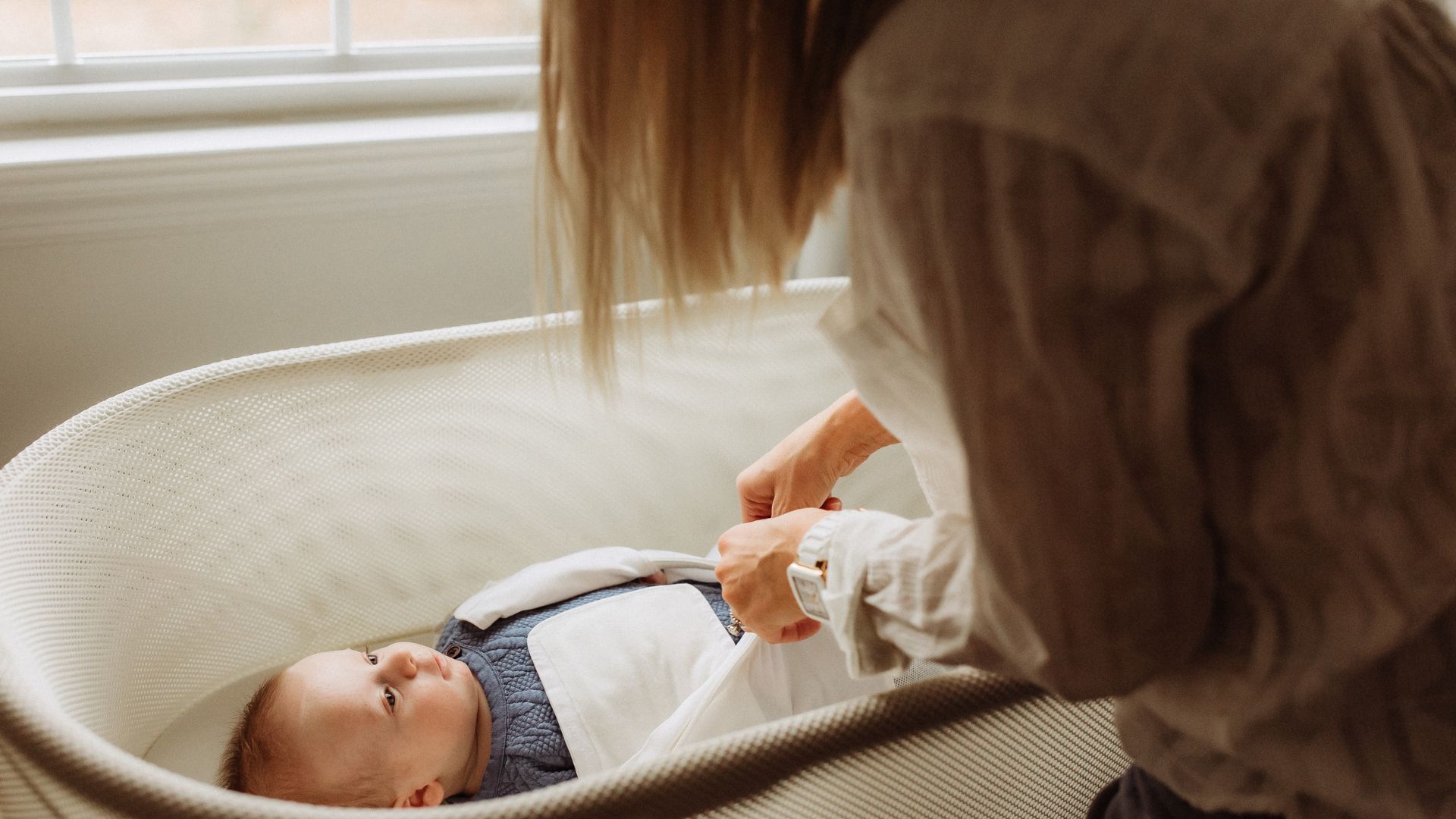Getting a newborn to sleep in a bassinet can be challenging for new parents. With erratic sleep patterns and a strong preference for the comfort of your arms, it’s no wonder it can feel like an uphill battle. However, understanding your newborn’s sleep patterns and creating a comfortable, safe environment can make the transition to bassinet sleeping smoother.
In this blog post, we’ll share practical tips and strategies to get your newborn to sleep in a bassinet to help you and your little one enjoy restful nights together.
Short Summary
- Create a comfortable bassinet environment to help your newborn sleep better, including swaddling and using white noise.
- Establish a consistent bedtime routine with activities like reading, singing & massaging.
- Follow safety guidelines and know when to transition from the bassinet to crib (3-6 months).
- Short Summary
- Active Sleep
- Frequent Waking
- Swaddling
- White Noise
- Darkness
- Bedtime Rituals
- Feeding and Diaper Changes
- Wind-down Time
- The “Bum First” Approach
- Using Sleep Props
- Moro Reflex
- Over or Undertiredness
- Why won’t my newborn sleep in a bassinet?
- Why will my newborn only sleep on me?
- How to put a baby to sleep?
- What is active sleep in newborns?
- What are some effective bedtime rituals for newborns?
Understanding Newborn Sleep Patterns
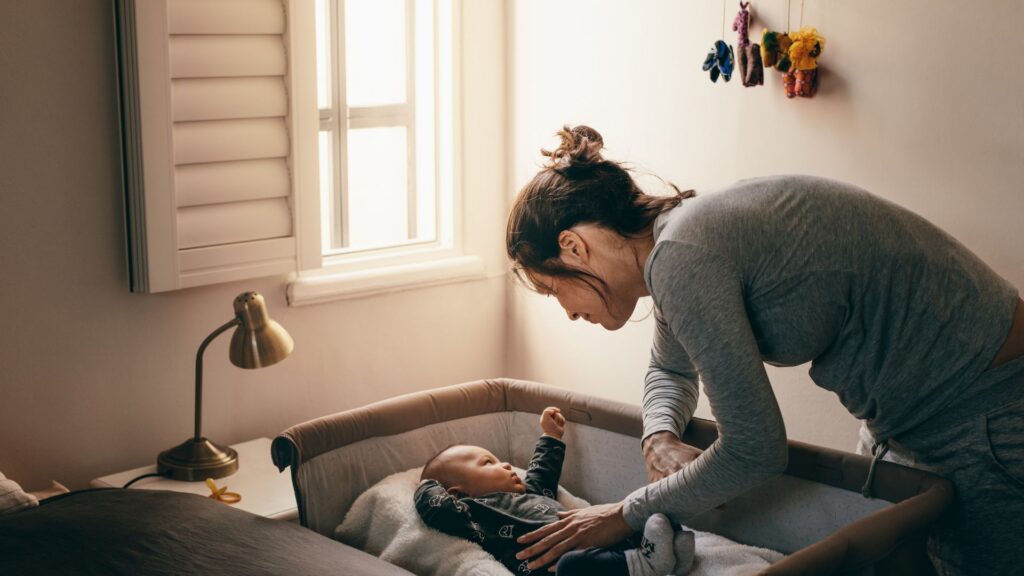
Newborn sleep patterns can seem unpredictable and confusing initially, but understanding them can help you adjust your expectations and strategies for getting your baby to sleep in a bassinet. Newborns experience active sleep and frequent waking, key components of their early sleep habits.
Getting the scoop on these patterns can help you figure out why your baby wakes frequently and how to soothe them back to sleep. Consistency is also vital in developing a sleep routine for your baby, as repetition helps them understand when it’s time for sleep.
Active Sleep
Active sleep is a type of sleep experienced by newborns, where they spend nearly half their sleep time in an easily disturbed state. During active sleep, your baby may move, groan, open their eyes, cry out, or breathe noisily or irregularly, making settling in a baby’s bassinet difficult.
Ensuring a safe sleep environment and creating a comfortable environment with swaddling, white noise, and darkness can help your newborn settle into a bassinet more easily.
Frequent Waking
Frequent waking is normal for newborns, as their tiny stomachs require them to eat every 2-3 hours. They may also wake up due to needing a diaper change, feeling uncomfortable, or simply out of habit. Understanding this lets you be more patient and persistent in getting your fussy baby to sleep in a bassinet.
To minimize disturbances, it’s essential to create a comfortable environment where your baby sleeps, including swaddling, using white noise, and ensuring darkness. Establishing a regular bedtime routine and ensuring the bassinet is comfortable can also help your baby sleep better.
Creating a Comfortable Bassinet Environment
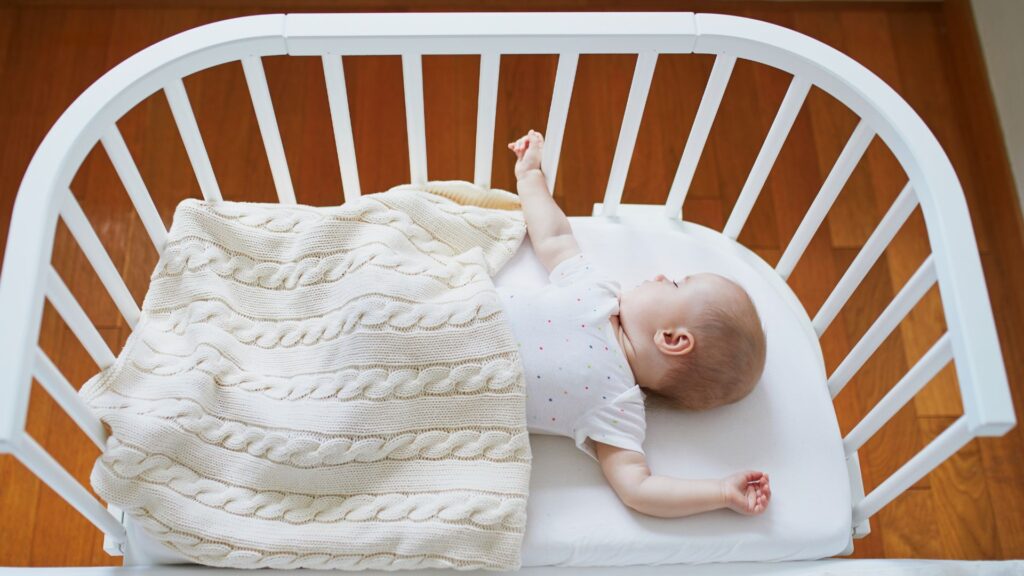
A comfortable bassinet environment is crucial for helping your newborn feel secure and sleep better. By swaddling, using white noise, and ensuring darkness, you can create a cozy atmosphere that will make it easier for your baby to settle in their bassinet.
A firm mattress that fits snugly in the bassinet is also essential to promote good sleep habits and reduce the risk of sudden infant death syndrome. Moreover, a pitch-black sleep environment can be achieved with blackout curtains, which, combined with a firm mattress, can help promote better sleep for your baby.
Swaddling
Swaddling involves wrapping newborns in a blanket to restrict their movement and provide a womb-like feeling, helping them feel secure while sleeping. This practice also helps prevent the Moro reflex, a startle reflex that can wake newborns up suddenly.
By understanding and managing the Moro reflex, you can prevent your baby from being startled awake and ensure they get the restful sleep they need in their bassinet.
White Noise
White noise can recreate the sounds of the womb, helping babies drift off to sleep by providing a calming and soothing atmosphere. White noise machines, such as the Hatch Baby Rest Sound Machine and the Yogasleep Rohm Portable White Noise Machine, can be placed near the bassinet to help your little one relax and sleep better.
Be sure to set the machine to a low volume and follow safe sleep guidelines to ensure your newborn’s best possible sleep environment.
Darkness
A dark environment is essential for newborns, as it helps recreate the womb-like atmosphere and encourages better sleep. To ensure a dark environment for your newborn, use blackout curtains, shades, or blinds to block out light from windows.
A nightlight or a dimmer switch can also be used to adjust the light in the room and create the perfect sleep setting for your baby.
Establishing a Sleep Routine
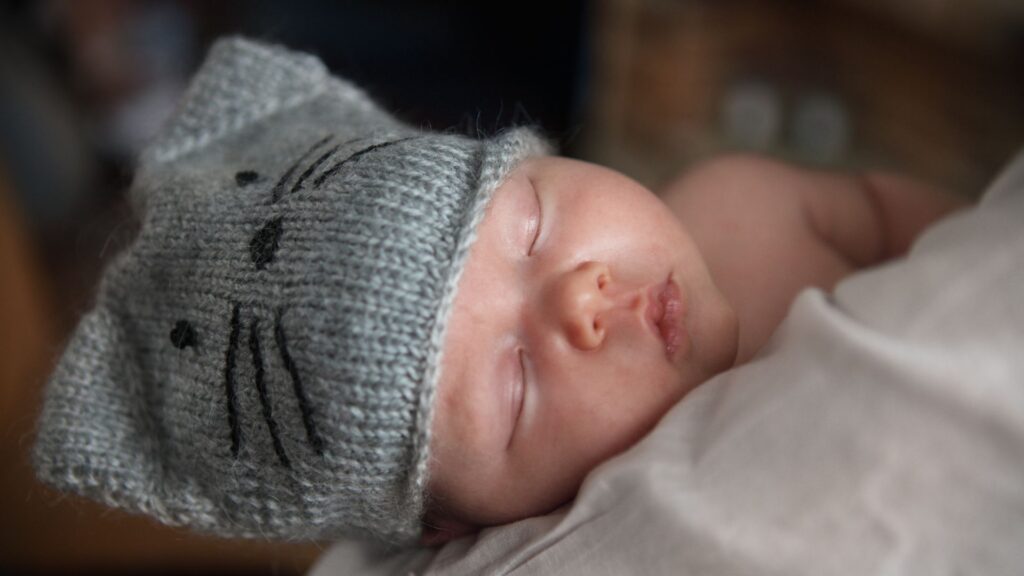
Establishing a sleep routine for your newborn is crucial for helping them adjust to sleeping in a bassinet. A consistent sleep routine includes bedtime rituals, feeding and diaper changes, and wind-down time, all of which can help your baby understand when it’s time to sleep.
Creating a routine that caters to your baby’s needs and preferences can ensure they feel more secure and comfortable in their bassinet, making for a smoother transition to independent sleep.
Bedtime Rituals
Consistent bedtime rituals can signal to newborns that it’s time to sleep and help them feel more secure in their bassinet. Picking a few activities you and your baby enjoy, such as reading a book, singing a lullaby, or giving a massage, can create a bedtime ritual your baby will look forward to each night.
Doing these activities in the same order every night can help your baby learn to associate them with sleep, making them more comfortable in their bassinet and making it easier to drift off.
Feeding and Diaper Changes
Ensuring your newborn babies are fed and have clean diaper before bedtime can help them feel more comfortable and sleep better in their bassinet. As I mentioned previously – newborns generally need to be fed every 2-3 hours and have their diaper changed just as often.
Meeting your baby’s basic needs can create a more comfortable sleep environment and promote restful sleep in their bassinet.
Wind-down Time
Wind-down time is essential for helping your newborn transition from being awake to falling asleep in their bassinet. Calming activities like singing lullabies, swaddling, or massaging your baby can help them relax and prepare for sleep.
Creating a consistent nightly routine and keeping the environment peaceful can make wind-down time more effective, ensuring your baby is ready for a restful night in the bassinet.
Transitioning from Arms to Bassinet
One of the biggest challenges you might face is transitioning your newborn from the comfort of your arms to sleeping in a bassinet. This transition can be made easier with the “bum first” approach and sleep props. These strategies can help your baby adjust to their new sleep environment and develop healthy sleep habits.
Using the “bum first” approach can help your baby feel secure.
The “Bum First” Approach
The “bum first” approach involves placing your baby in the bassinet with their bottom first, helping them feel secure and preventing the Moro reflex from startling them awake. Gently guide your baby’s head and shoulders into the bassinet, ensuring they feel comfortable and secure.
By preventing the Moro reflex, you can help your newborn feel more at ease in their bassinet and encourage a smoother transition to independent sleep.
Using Sleep Props
Sleep props, such as a parent’s scent or a warm washcloth, can help recreate the comforting sensations of being held and encourage newborns to sleep in their bassinet. The washcloth trick, for example, involves placing a small warm cloth between the baby’s head and your hand while they drift off in your arms, then leaving the warm cloth in the bassinet when transferring them.
By using sleep positioners and other sleep props to provide a sense of familiarity and comfort, you can help your baby feel more secure and sleep better in their bassinet.
Addressing Common Sleep Challenges
Every newborn is unique, and common sleep challenges such as the Moro reflex and over or undertiredness can make it difficult for some babies to sleep in a bassinet. By understanding and addressing these challenges, you can find solutions for your baby and help them get the rest they need in their bassinet.
Creating a comfortable and safe sleep environment is essential for your baby’s health and well-being.
Moro Reflex
The Moro reflex is a normal protective response in newborns that causes them to wake up when they feel like falling. By managing the Moro reflex with techniques like swaddling and the “bum first” approach, you can prevent your baby from being startled awake and help them get a more restful sleep in their bassinet.
Understanding the Moro reflex and how it affects your newborn’s sleep can make all the difference in helping them transition to bassinet sleeping.
Over or Undertiredness
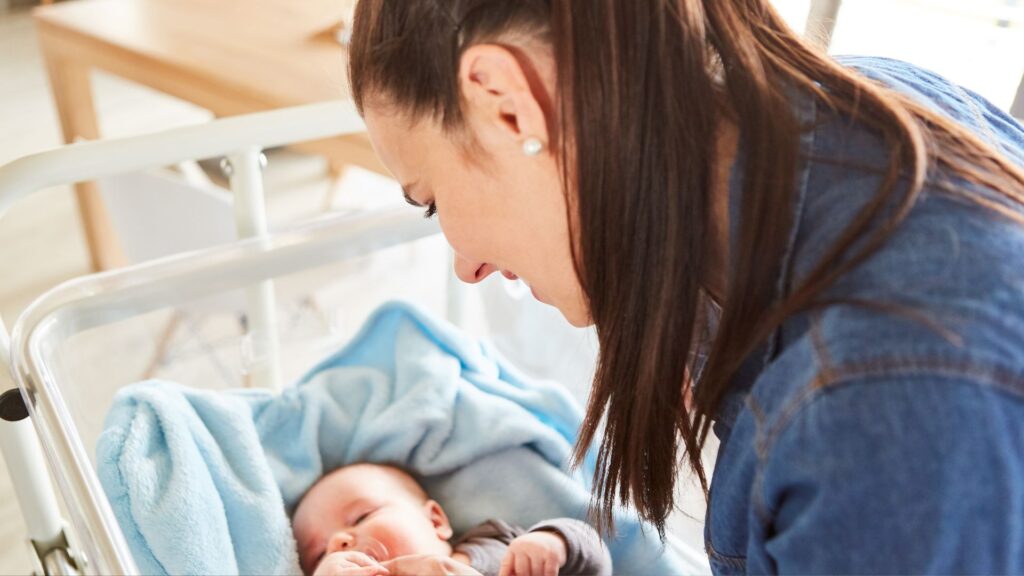
Ensuring that your overtired newborn baby is neither over nor undertired can help them fall asleep more easily in their bassinet.
An overtired newborn may be almost inconsolable, making it challenging to settle down and sleep.
Paying attention to your baby’s sleep cues and adjusting their routine can help them find the right balance and enjoy a restful sleep in their bassinet.
Bassinet Safety Guidelines
Creating a safe sleep environment for your newborn is crucial to their well-being and your peace of mind. By following bassinet safety guidelines, such as ensuring a firm mattress, avoiding loose bedding, and adhering to the Consumer Product Safety Commission (CPSC) standards, you can create a safe and comfortable sleep space for your baby.
Remember, a safe sleep environment is the foundation for a restful night’s sleep for you and your newborn.
When to Transition to a Crib
As your baby grows and their sleep needs change, it’s important to know when to transition from a bassinet to a crib. Typically, this transition occurs between 3 and 6 months, depending on your baby’s weight, height, and developmental milestones. By recognizing the signs that your baby is ready for a crib, you can plan for this transition and continue to support their sleep needs as they grow.
Signs that your baby is ready for a crib include being able to roll over and sit up.
Conclusion
In conclusion, getting your newborn to sleep in a bassinet involves understanding their sleep patterns, creating a comfortable and safe environment, establishing a sleep routine, and addressing common sleep challenges. By implementing these strategies and following bassinet safety guidelines, you can help your baby develop healthy sleep habits and enjoy restful nights together.
May your journey into parenthood be filled with sweet dreams and peaceful sleep!
Frequently Asked Questions
Why won’t my newborn sleep in a bassinet?
It could be that your baby is not tired enough or needs to be fed. Try increasing the awake time before nap time.
Ensure they are fed and change their diaper before putting them in the bassinet.
Why will my newborn only sleep on me?
Your newborn seeks the same comfort they experienced in the womb – your warm, familiar body with subtle movements and a reassuring heartbeat.
That’s why they prefer to sleep on you!
How to put a baby to sleep?
Try giving your baby a warm bath before bedtime, putting on fresh night clothes and nappy, brushing their teeth (if they have any), reading a bedtime story, dimming the lights in the room, giving them a goodnight kiss and cuddle – these are some great things to do to put your baby to sleep.
Creating a bedtime routine is a great way to help your baby relax and get ready for sleep. It can also help you feel more in control of bedtime. Make sure to keep the routine consistent and enjoyable for your baby.
What is active sleep in newborns?
Active sleep in newborns is characterized by movement, noise, and easy disturbance, making it difficult for them to settle in a bassinet.
Due to their active sleep patterns, newborns often have difficulty settling into a bassinet. Movement, noise, and easy disturbance can make it difficult for them to stay asleep.
What are some effective bedtime rituals for newborns?
Creating a consistent and calming bedtime ritual for newborns can help them relax and quickly fall asleep. Consider activities such as reading a book, singing a lullaby, or giving a massage to signal that it is time to sleep.
Hi – I’m Alina and I am a soon to be mom going through the journey of becoming a parent. I am a writer at heart and I love sharing about pregnancy tips and other busy mom hacks.
